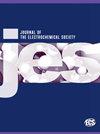ZCuPb10Sn10 合金在 NaNO3 溶液中的电化学溶解行为
IF 3.3
4区 工程技术
Q2 ELECTROCHEMISTRY
引用次数: 0
摘要
铜合金(如 ZCuPb10Sn10)已被广泛应用于各种产品的摩擦副。为改善摩擦学性能,微凹凸阵列等表面纹理引起了全世界研究人员的极大关注。为了通过电化学加工在 ZCuPb10Sn10 合金上生成微凹凸阵列,研究 ZCuPb10Sn10 在 NaNO3 溶液中的电化学溶解行为至关重要。本文通过实验测试研究了 ZCuPb10Sn10 合金在 NaNO3 溶液中的电化学溶解行为。通过阳极极化、塔菲尔极化和电化学阻抗谱来研究其被动和腐蚀行为。分析了不同条件下溶解表面的微观结构和成分。此外,还提出了一个模型来解释高压静水条件下 ZCuPb10Sn10 合金在 NaNO3 溶液中的电化学溶解过程。最终,选择了浓度为 10%、温度为 20 ℃ 的 NaNO3 溶液作为电解质,并在 ZCuPb10Sn10 合金表面成功地通过掩膜电化学微加工生成了平均直径为 119.7 μm、深度为 7.4 μm 的微细孔阵列。本文章由计算机程序翻译,如有差异,请以英文原文为准。
Electrochemical Dissolution Behavior of ZCuPb10Sn10 Alloy in NaNO3 Solution
Copper alloys, such as ZCuPb10Sn10, have been widely applied to friction pairs in various products. Surface texture, such as micro-dimple array has attracted significant attention from researchers worldwide to improve tribological performance. To generate micro-dimple array on ZCuPb10Sn10 alloy by electrochemical machining, it is essential to investigate the electrochemical dissolution behavior of ZCuPb10Sn10 in NaNO3 solution. In this paper, the electrochemical dissolution behavior of ZCuPb10Sn10 alloy in NaNO3 solution is investigated through experimental tests. Anodic polarization, Tafel polarization, and electrochemical impedance spectroscopy were conducted to investigate its passive and corrosion behavior. The microstructure and composition of the dissolved surfaces were analyzed under various conditions. Additionally, a model was proposed to explain the electrochemical dissolution process of ZCuPb10Sn10 alloy in NaNO3 solution under high pressure hydrostatic conditions. Ultimately, a NaNO3 solution with 10% in concentration and 20 °C in temperature was selected as the electrolyte and a micro-dimple array with an average diameter of 119.7 μm and a depth of 7.4 μm was successfully generated with through-mask electrochemical micromachining on the surface of ZCuPb10Sn10 alloy.
求助全文
通过发布文献求助,成功后即可免费获取论文全文。
去求助
来源期刊
CiteScore
7.20
自引率
12.80%
发文量
1369
审稿时长
1.5 months
期刊介绍:
The Journal of The Electrochemical Society (JES) is the leader in the field of solid-state and electrochemical science and technology. This peer-reviewed journal publishes an average of 450 pages of 70 articles each month. Articles are posted online, with a monthly paper edition following electronic publication. The ECS membership benefits package includes access to the electronic edition of this journal.

 求助内容:
求助内容: 应助结果提醒方式:
应助结果提醒方式:


